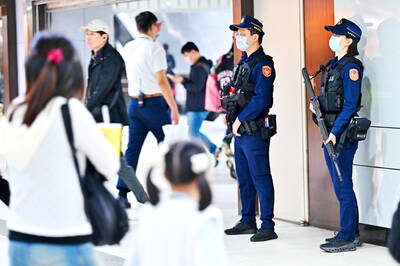Toyota Motor Corp, Nissan Motor Co and Honda Motor Co, Japan's three largest carmakers, increased global vehicle production last month from a year ago to meet rising demand in North America, Asia and China.
Nissan boosted production 17.2 percent, it said in a statement. Honda increased production 12.3 percent and Toyota expanded production 4.9 percent, they said separately. Mazda Motors Corp. and Mitsubishi Motors Corp. both cut production.
Toyota, Honda and Nissan are expected by analysts to have record profits for the fiscal year ending next month. The companies are building new factories overseas or expanding existing plants to meet demand for Toyota Corollas, Honda Accords and Nissan Pathfinders. The carmakers are taking customers from General Motors Corp., Ford Motor Co. and Volkswagen AG.
"The Japanese automakers are well positioned in the global auto market," said Makoto Sakuma, who helps oversee US$3.8 billion at Asahi Life Asset Management Co. in Tokyo. "Honda especially did well with attaining double-digit growth in global production." Toyota shares fell 0.5 percent to ?4,030 in Tokyo at 1:35pm Nissan shares declined 1.2 percent to ?1,101 and shares of Honda rose 1.6 percent to ?5,590.
Toyota made 555,319 vehicles worldwide last month, the Toyota City, Japan-based automaker said. Domestic output rose 1.2 percent to 298,209 units helped by demand for the Mark X sedan and Isis minivan, while overseas output gained 9.5 percent to 257,110 units. Exports fell 2.8 percent to 144,385 vehicles.
Nissan made 292,254 vehicles globally last month. Domestic production gained 20 percent to 136,276 units, while overseas output rose 14.9 percent to 155,978 units. Exports from Japan fell 8.5 percent to 52,078 vehicles.
Honda made 270,438 vehicles last month, the company said in a statement. Overseas production rose 9.6 percent to 164,409 units last month, while domestic production gained 16.6 percent to 106,029 units.
Mazda, Japan's fourth-largest carmaker, said its global auto output fell 18.2 percent last month because a fire damaged one of its factories last year.
The carmaker produced 73,936 vehicles last month, the Hiroshima, Japan-based company said in a statement. Production outside Japan fell 15.5 percent to 20,650 units. Domestic output fell 19.2 percent to 53,286 units, and exports from Japan dropped 10.5 percent to 38,864 vehicles, Mazda said.
One of Mazda's factories was damaged by a fire Dec. 15. The company plans to reopen the plant in April after installing a new paint shop. The Ujina No. 1 plant produces 30 percent of Mazda' annual domestic capacity, building models including the Mazda2/Demio compact car, MPV minivan, Bongo van, Verisa compact car and RX-8.
Mazda's shares fell 0.6 percent to ?343.
Mitsubishi Motors, Japan's fifth-largest automaker, said global production fell 11 percent last month from a year earlier as sales plunged in Japan and in the US.
Mitsubishi Motors made 101,937 vehicles worldwide last month, the Tokyo-based company said in a statement. Domestic production fell 15.2 percent to 50,308 units, while overseas output dropped 5 percent to 51,629 units. Exports from Japan dropped 18.2 percent to 22,249 vehicles.
Mitsubishi Motors shares fell 1.4 percent to ?137.

TRAGEDY STRIKES TAIPEI: The suspect died after falling off a building after he threw smoke grenades into Taipei Main Station and went on a killing spree in Zhongshan A 27-year-old suspect allegedly threw smoke grenades in Taipei Main Station and then proceeded to Zhongshan MRT Station in a random killing spree that resulted in the death of the suspect and two other civilians, and seven injured, including one in critical condition, as of press time last night. The suspect, identified as a man surnamed Chang Wen (張文), allegedly began the attack at Taipei Main Station, the Taipei Fire Department said, adding that it received a report at 5:24pm that smoke grenades had been thrown in the station. One man in his 50s was rushed to hospital after a cardiac arrest

PUBLIC SAFETY: The premier said that security would be tightened in transport hubs, while President Lai commended the public for their bravery The government is to deploy more police, including rapid response units, in crowded public areas to ensure a swift response to any threats, President William Lai (賴清德) said yesterday after a knife attack killed three people and injured 11 in Taipei the previous day. Lai made the remarks following a briefing by the National Police Agency on the progress of the investigation, saying that the attack underscored the importance of cooperation in public security between the central and local governments. The attack unfolded in the early evening on Friday around Taipei Main Station’s M7 exit and later near the Taipei MRT’s Zhongshan

SAFETY FIRST: Double the number of police were deployed at the Taipei Marathon, while other cities released plans to bolster public event safety Authorities across Taiwan have stepped up security measures ahead of Christmas and New Year events, following a knife and smoke bomb attack in Taipei on Friday that left four people dead and 11 injured. In a bid to prevent potential copycat incidents, police deployments have been expanded for large gatherings, transport hubs, and other crowded public spaces, according to official statements from police and city authorities. Taipei Mayor Chiang Wan-an (蔣萬安) said the city has “comprehensively raised security readiness” in crowded areas, increased police deployments with armed officers, and intensified patrols during weekends and nighttime hours. For large-scale events, security checkpoints and explosives

ON ALERT: Taiwan’s partners would issue warnings if China attempted to use Interpol to target Taiwanese, and the global body has mechanisms to prevent it, an official said China has stationed two to four people specializing in Taiwan affairs at its embassies in several democratic countries to monitor and harass Taiwanese, actions that the host nations would not tolerate, National Security Bureau (NSB) Director-General Tsai Ming-yen (蔡明彥) said yesterday. Tsai made the comments at a meeting of the legislature’s Foreign Affairs and National Defense Committee, which asked him and Minister of National Defense Wellington Koo (顧立雄) to report on potential conflicts in the Taiwan Strait and military preparedness. Democratic Progressive Party (DPP) Legislator Michelle Lin (林楚茵) expressed concern that Beijing has posted personnel from China’s Taiwan Affairs Office to its